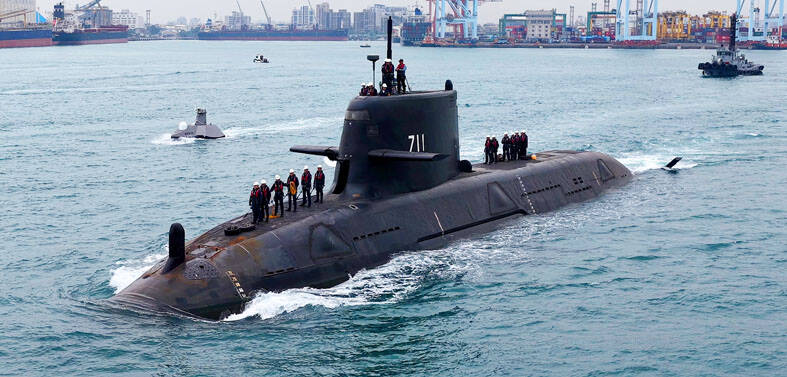Workers on Sept. 20 began restoration work at Tainan’s Tang Te-chang Memorial Park (湯德章紀念公園), with city officials saying they hope the park can fit in better with the surrounding Japanese architecture that dates to the colonial period.
Restoration of the park, which is situated atop the city’s largest traffic circle, is to cost NT$8 million (US$263,713) and take 150 days to complete, at the end of February, the Tainan Cultural Affairs Bureau said.
The bureau said the park is a focal point of urban development efforts due to its important position at the confluence of seven major avenues that spread out to every area of the city. In the park’s immediate vicinity are the Land Bank of Taiwan branch, the Hayashi Department Store, Wude Temple — originally established by the Japanese as the Butokuden, a martial arts center — and other examples of period Japanese architecture.
The park at the south slope of Jiou Ling (鷲嶺) — the city’s highest point — was originally the site of the San Jie altar (三界) built during the Qing Dynasty.
In 1907 local residents erected a statue at the site to commemorate Viscount Kodama Gentaro, a general in the Imperial Japanese Army who became the fourth Governor-General of Taiwan.
Walls surrounding the park came down after the site became a traffic circle under new urban planning designs in 1911.
The park and its surrounding traffic circle were officially named Kodama Park in 1916, but were shortly after renamed Taisho Park after the town, then called Taisho Township (大正町), in which it is situated.
Upon the arrival of the Chinese Nationalist Party (KMT) to Taiwan following World War II, the park was renamed Min Sheng Green Park (民生綠園).
The park was given its current name in 1997 by then-Tainan mayor George Chang (張燦鍙). Chang erected a bust at the section of the traffic circle leading to Zhongshan Road, where lawyer and democracy advocate Tang Te-chang (湯德章) was shot by soldiers during the 228 Incident in 1947.
A statue of Republic of China founder Sun Yat-sen (孫中山) stood in the center of the park until 2014, when it was defaced and torn down by the Alliance of Referendum for Taiwan and its supporters.
In December 2015, artists working in the old Japanese Imperial Army barracks found the original head of the Kodama statue that had long ago been torn down and gone missing.
Research by the bureau found that the bust was made in Italy from gypsum and was imported to Taiwan in 1904. In 1905 it was shipped to Tainan and the statue was erected in 1907. The bureau had the bust restored and put away in storage, saying there are no plans to rebuild the entire body of the statue or re-erect it in Tang Te-chang Memorial Park.
This cultural landmark will be a site for exhibiting artwork once the restoration is completed, bureau Division of Cultural Assets Director Lin Chiao-in (林喬彬) said.

US climber Alex Honnold is to attempt to scale Taipei 101 without a rope and harness in a live Netflix special on Jan. 24, the streaming platform announced on Wednesday. Accounting for the time difference, the two-hour broadcast of Honnold’s climb, called Skyscraper Live, is to air on Jan. 23 in the US, Netflix said in a statement. Honnold, 40, was the first person ever to free solo climb the 900m El Capitan rock formation in Yosemite National Park — a feat that was recorded and later made into the 2018 documentary film Free Solo. Netflix previewed Skyscraper Live in October, after videos

NUMBERS IMBALANCE: More than 4 million Taiwanese have visited China this year, while only about half a million Chinese have visited here Beijing has yet to respond to Taiwan’s requests for negotiation over matters related to the recovery of cross-strait tourism, the Tourism Administration said yesterday. Taiwan’s tourism authority issued the statement after Chinese-language daily the China Times reported yesterday that the government’s policy of banning group tours to China does not stop Taiwanese from visiting the country. As of October, more than 4.2 million had traveled to China this year, exceeding last year. Beijing estimated the number of Taiwanese tourists in China could reach 4.5 million this year. By contrast, only 500,000 Chinese tourists are expected in Taiwan, the report said. The report

Temperatures are forecast to drop steadily as a continental cold air mass moves across Taiwan, with some areas also likely to see heavy rainfall, the Central Weather Administration (CWA) said. From today through early tomorrow, a cold air mass would keep temperatures low across central and northern Taiwan, and the eastern half of Taiwan proper, with isolated brief showers forecast along Keelung’s north coast, Taipei and New Taipei City’s mountainous areas and eastern Taiwan, it said. Lows of 11°C to 15°C are forecast in central and northern Taiwan, Yilan County, and the outlying Kinmen and Lienchiang (Matsu) counties, and 14°C to 17°C

STEERING FAILURE: The first boat of its class is experiencing teething issues as it readies for acceptance by the navy, according to a recent story about rudder failure The Hai Kun (海鯤), the nation’s first locally built submarine, allegedly suffered a total failure of stern hydraulic systems during the second round of sea acceptance trials on June 26, and sailors were forced to manually operate the X-rudder to turn the submarine and return to port, news Web site Mirror Daily reported yesterday. The report said that tugboats following the Hai Kun assisted the submarine in avoiding collisions with other ships due to the X-rudder malfunctioning. At the time of the report, the submarine had completed its trials and was scheduled to begin diving and surfacing tests in shallow areas. The X-rudder,